In this guide, we’re sharing 3 tactics for white hat link building that won’t break the bank.
If you’re starting out with link building, you’re going to need this guide.
Here’s what you’re going to learn:
- What is white hat link building?
- How is white hat backlink building different from other tactics?
- 3 white hat tactics that are easy to implement, even for beginners.
Let’s get into it.
Link building cheat sheet
What is White Hat Link Building?
If you know a thing or two about link building, you’ve probably heard of how time consuming and demanding it can be.
However, no matter how hard it might sound, link building is actually one of the most efficient ways to grow your organic traffic and get results from organic search faster.
In fact, according to a 2019 survey by SparkToro, most white hat SEO professionals still believe that the quality of linking websites – AKA referring domains – is one of the most prominent search engine ranking factors.
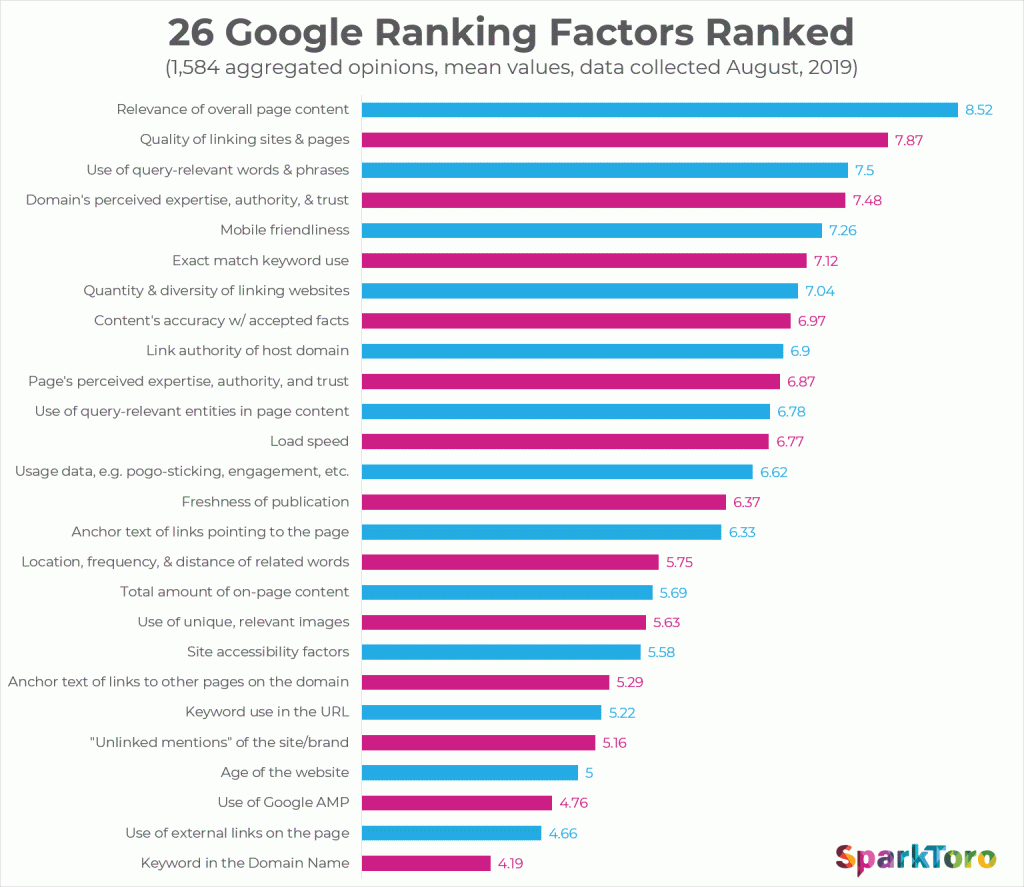
At the same time, according to a 2020 study of 11.8 million search results by Backlinko,
“A site’s overall link authority (as measured by Ahrefs Domain Rating) strongly correlates with higher rankings.”
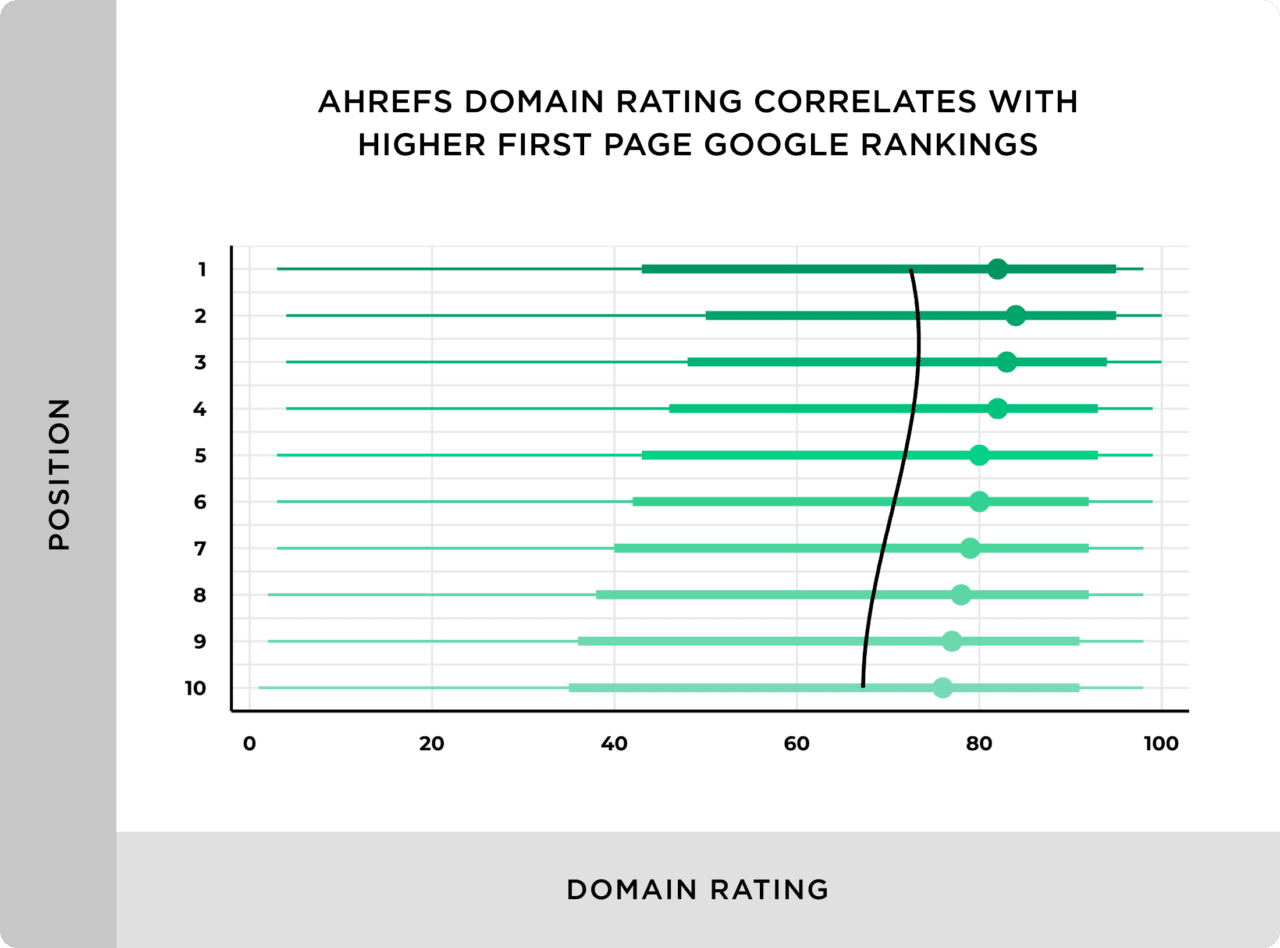
What does that mean?
Well, practically it says that links matter a lot when it comes to getting organic traffic.
Also, when it comes to search engine optimization (more specifically, off-page SEO), one of the most prominent activities is link building.
In this post we’re focusing solely on a white hat SEO technique, white hat link building in particular.
The reason we’re focusing on white hat link building, although we’re also showing you how it differs from gray and black hat link building, is simple.
White hat is a legally not objectionable SEO strategy that boosts higher and more positive ratings by search engines.
Put another way, white hat is an efficient and ethical way of working within search engines’ conditions of acquiring higher visibility and getting higher search engine result page (SERP) positions.
We could say that white hat methods are the heroes; the good guys that can help you improve your search engine rankings while respecting the ranking factors search engines are looking for.
An example would be to look out for broken links on other websites.
After having identified any broken links, you can reach out to the person that had initially published them and let them know about it.
This will also give you the chance to suggest they should replace their broken links with links back to your content that might be similar.
The problem with broken link building, however, is that it’s not easily scalable. People tend to remove broken links from their site pretty quickly – similar to unlinked mentions that are so few and far between.
Another example would be to promote an infographic that you’ve created to relevant websites who might be interested in featuring your visualisation in one of their posts and linking back to your website.
For example, let’s say that you’ve published an infographic on your blog and want to start building links back to the page where the infographic is.
It only makes sense that you’ll find relevant websites that talk about this topic and reach out to them, e.g. to the webmaster of the website or someone with editorial access to the blog, and ask if they could take a look at your infographic.
The purpose here is to ask for dofollow links, which are the opposite of nofollow links, and help your page get the attention it deserves as well as acquire some referral traffic, if the linking page has traffic of its own.
As you’ll see when we get deeper into the three different white hat link building tactics a little further down in this post, white hat is all about targeted prospecting, crafting a personalized pitch, and managing the outreach process end-to-end.
To cut a long story short, outreach helps you find and acquire high-quality links from high authority websites and even generate brand mentions along the way.
Getting relevant links from websites that have a high domain authority (DA) can lead to increasing your overall domain authority and, as a result, getting you more visibility on the SERPs.
Let’s now discuss how white hat tactics differ from black and grey link building technique types.
The Difference Between Black, Grey, and White Hat Link Building Techniques
As we’ve already discussed, white hat techniques are, to put it simply, the ‘good’ ones.
The tactics that, although demanding, can help you rank higher organically and in a way that doesn’t violate Google’s guideliness.
Let’s now discuss grey hat link building.
Grey Hat Link Building
Grey hat link building is basically a combination of techniques that are white hat, so approved by the search engines, and others that are not the worst things you can do but are still manipulative and might put your business at risk.
In a few words, grey hat link building strategies might get you in a little trouble, although they’re not violating Google and Bing’s guidelines as much as black hat techniques do.
Some examples of gray hat SEO techniques are:
- Buying expired domains with a high number of links linking back to them
- Buying links to your site from other websites in bulk without adding the rel=”sponsored” tag
How about black hat link building?
Black Hat Link Building
Black hat SEO is that type of SEO you should try to stay well away from as it could lead to your business getting severe penalties from the search engines.
In some cases, the effects of such a penalty for your business may be permanent.
In one sentence, black hat tactics violate search engine guidelines.
Let’s take a look at what Google considers to be a violation of their guidelines.
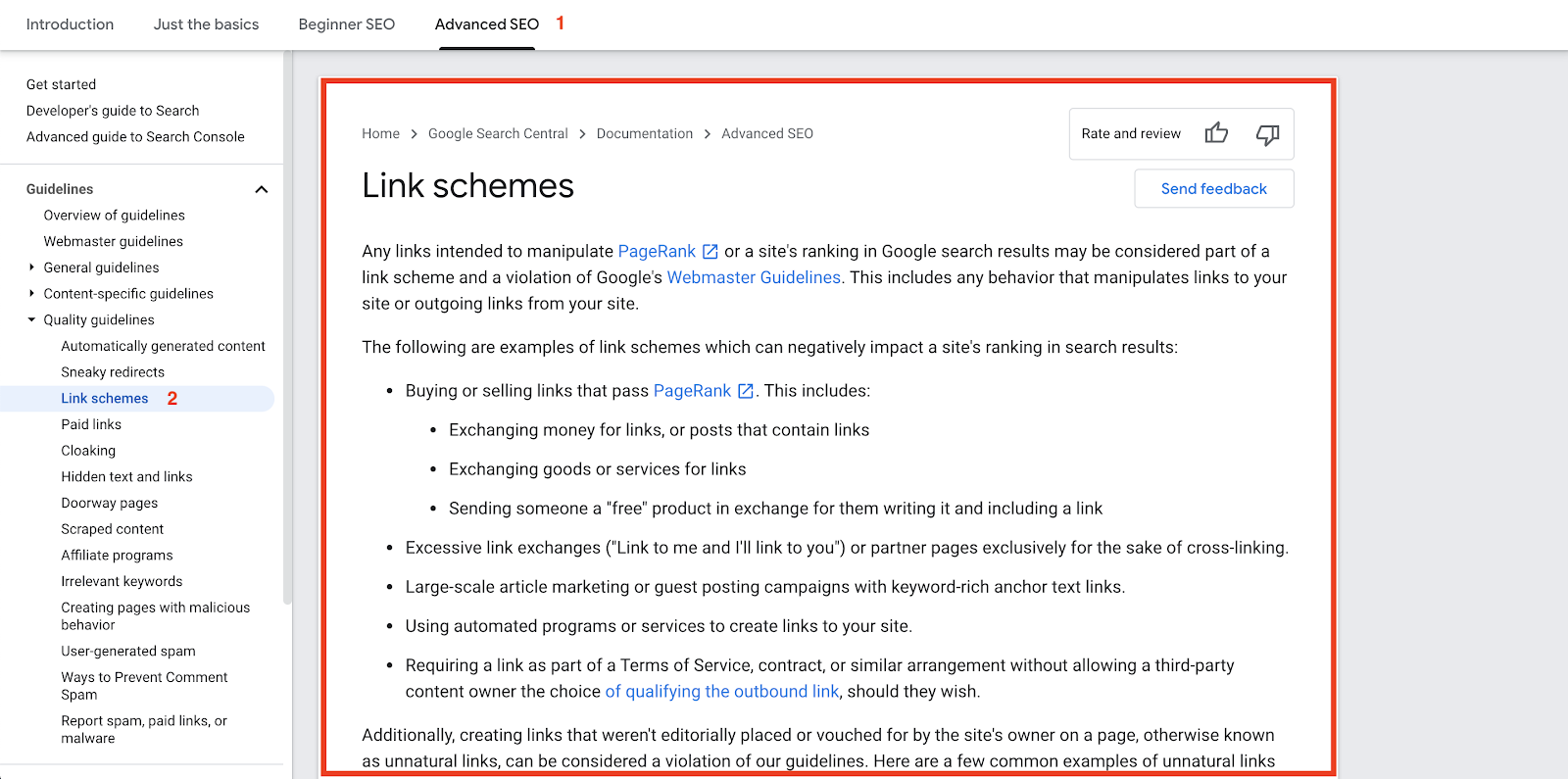
Author’s Note: To access the above page, you need to visit Google’s Search Central and from there click on “Link schemes”. This is part of Google’s “Advanced SEO”, but is enough to help you understand which practices are considered to be a link scheme by Google when it comes to SEO link building.
Here are a few examples:
- Hiding keywords and anchor texts in a blog post or other website page by turning the anchor text to the same color as the page background
- Cloaking, which is the process of presenting different content to the users than what you show the search engines
- Buying links on website networks that are presented to be high authority links but aren’t
- Click-through rate (CTR) manipulation
- Negative SEO services, such as toxic link attacks
- Participating in a private blog network (PBNs)
- Link farm posts or entire sites
- Paid link collaborations with no sponsored tag
- Using an automated link building service, such as a bot spamming social media and blog comments with your links
We understand that marketers and website owner teams might desperately want to boost their company’s high quality backlink profile, but they should also be aware of the risks.
Overall, using black and gray link building tactics and SEO strategies can be risky for your website and affiliate sites.
Professionals and brands who employ such tactics and methodologies may get away with it for a while, but sooner or later things will come out, and, in many cases, this may result in huge traffic, revenue, and job losses.
Whether you’re doing your own SEO or working with an SEO agency, keep in mind that Google’s algorithms are only getting stricter and smarter when it comes to the tactics one uses to get higher visibility and acquire links.
Moving on to our white hat link building strategies.
Tactic #1: Guest Post Outreach
We’ve now established that black and gray hat link building can be far more effective and sustainable than other tactics.
Let’s now get into how you could achieve white hat link building by using the power of guest post outreach.
In this section we’re taking you through the process of prospecting, or finding guest blogging opportunities by reaching out to other websites, bloggers, and online media outlets.
Call it whatever you like.
Author’s Note: Online media outlets and publications are different from social media, where most links are turned into nofollow by default and therefore generally make little to no difference to your backlink profile.
For the sake of example, let’s say that we at Respona, are interested in doing guest posts to acquire white hat links for our website.
Therefore, we’re interested in finding websites that:
- Accept guest posts
- Write about topics that are relevant to Respona’s capabilities.
Additionally, we’re interested in writing about one of the following topics:
- Email outreach
- Digital PR
- Link building
- Content marketing
For the step-by-step process I’m about to talk you through, we’re using Respona as our outreach tool of choice.
It comes with pre-designed campaign templates for every single strategy in this article.
The very first step is to start a new campaign, using the “Guest post” campaign template.
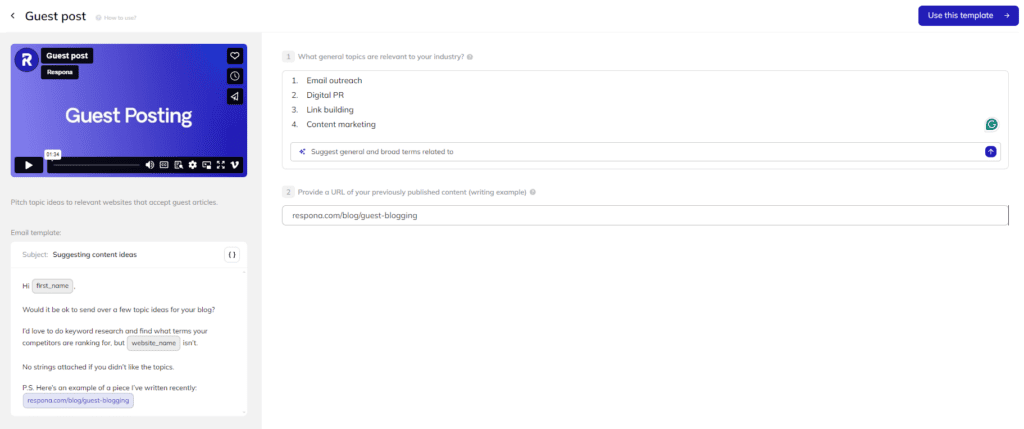
To use it, we only need to fill out two simple fields.
In the first one, enter your target keywords.
You can also use Respona’s AI keyword suggestions to generate 20 additional general and broad terms related to your keywords.
These keywords will be used by Respona’s search engine to find relevant “Write for us” pages.
In the second field, paste a link to an example of one of your previous guest posts.
It will be pulled into your email sequence.
Speaking of email sequences, once you click “use this template”, you’ll be brought into Respona’s campaign editor, the first step of which is to review your email sequence.
Every campaign template comes with its own email sequence template, but we encourage you to take a moment to refine it or, even better, create your own.
More specifically, your initial guest posting outreach email as well as your follow-up email, in case your initial email goes unanswered.
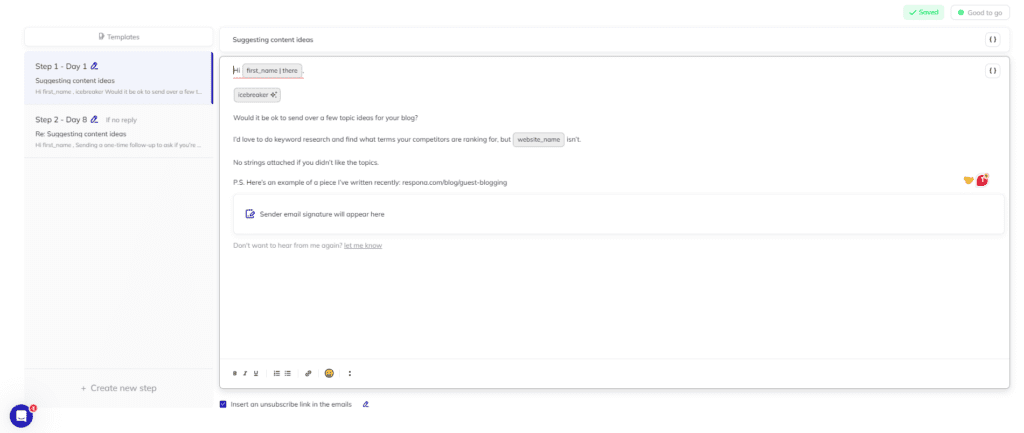
Note the “Icebreaker” variable that we used as our opening line.
It’s AI – powered variable that will generate unique personalizations for every opportunity in your campaign to increase your reply rates.
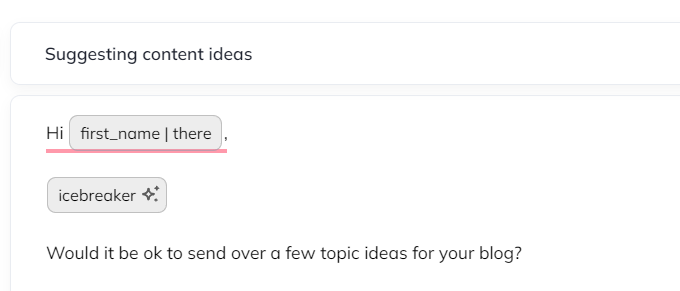
Here’s the full email template we’ll be using:
Hey {first_name},
{Icebreaker}
Would it be ok to send over a few topic ideas for your blog?
I’d love to do keyword research and find what terms your competitors are ranking for, but {website_name} isn’t.
No strings attached if you didn’t like the topics.
P.S. Here’s an example of a piece I’ve written recently: respona.com/blog/guest-blogging
When preparing your email outreach using one of Respona’s templates, you also get insight on the chances your email has of getting read.
Have a look:

Your follow-up email can be found right under your initial email, as highlighted below:
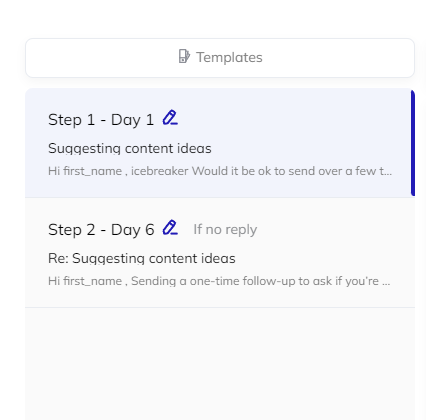
Let’s also add an unsubscribe link to our email pitch.
These are great for providing your prospects with an easy way to opt out from further communications incase they are not insterest – and you can customize the eact sentence and link.
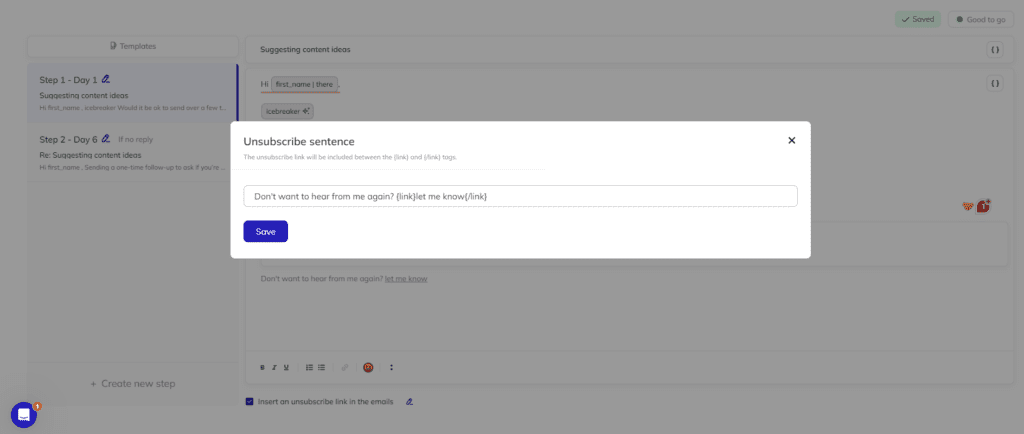
After having personalized your email sequence, you can get to the next step – which is to find guest posting opportunities, and their associated contact information in one go.
Because we used a campaign template, Respona’s search engine is already locked and loaded to find relevant websites that accept guest posts.
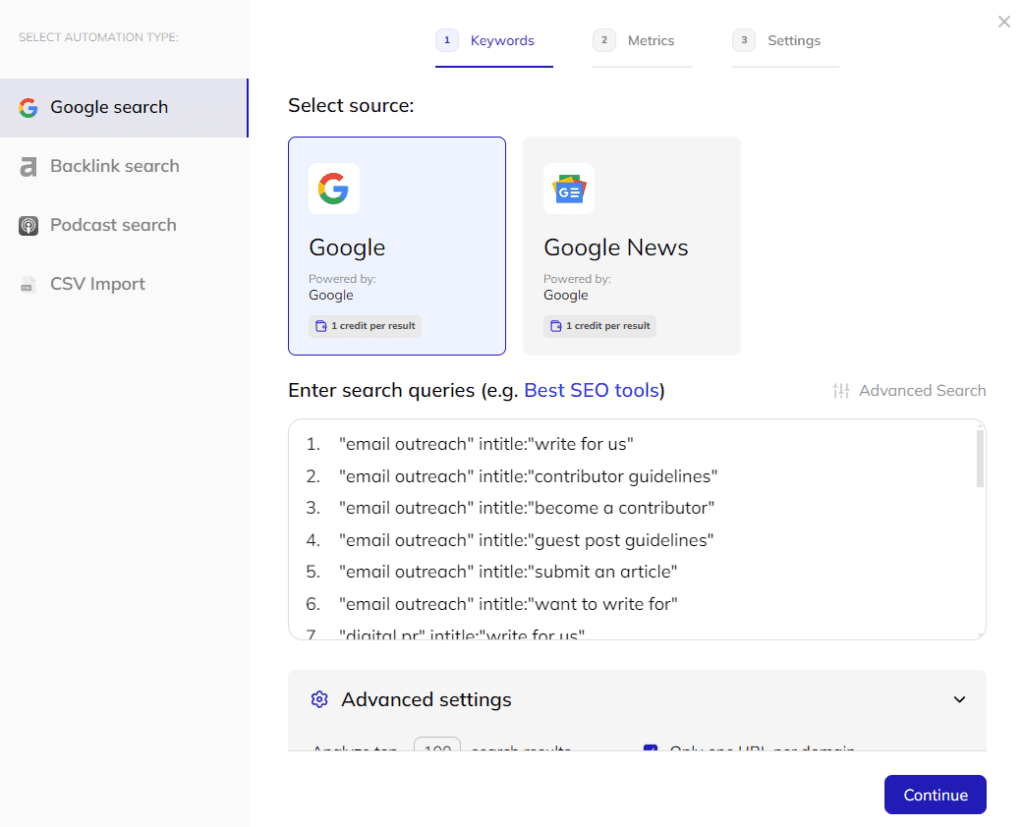
It does so by applying the “intitle:” advanced search operator in combination with the most popular write for us page title variations like “submit an article”, “guest post guidelines”, “become a contributor”, etc.
Click “Continue” and apply some additional SEO filters to narrow down the results to blogs that are beneficial for you to write for.
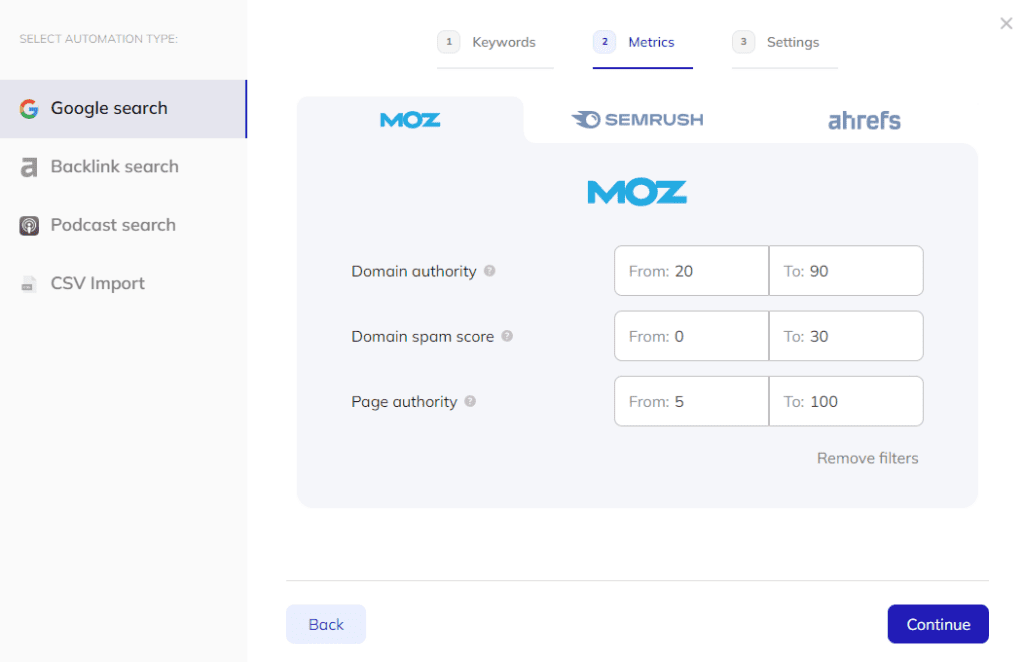
By default, Respona is integrated with Moz, so these filters are available to all users, even if you don’t have a Moz account.
However, if you have an account with Ahrefs or Semrush, you can choose to connect it to Respona and use those SEO tools’ proprietory filters as well.
When ready, click “continue” to review Respona’s contact finder settings.
Because we’re using a campaign template, the contact finder is already pre-set to find relevant decision-makers for guest posting, such as SEO and content managers, marketers, etc. – at all seniority levels.
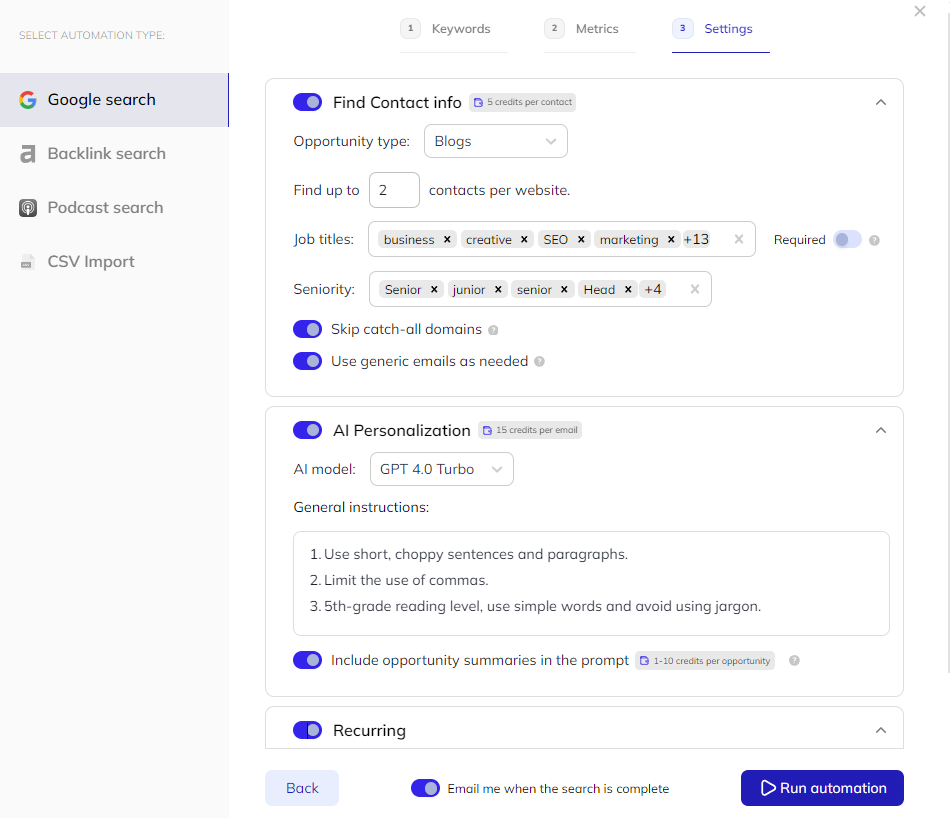
In the next field, let’s provide our AI personalizations with some additional instructions for tone and style to sound more like us.
You can also use examples of your previous personalizations as training data for the AI.
The last setting enables your search to be recurring, meaning REspona will automatically re-run it every couple of weeks, and automatically add new opportunities to your campaign.
Once you click “Run automation”, Respona will start looking for guest posting opportunities, their contact information, and personalizing your emails.
Once the automation is started, results will start popping up on the screen as soon as they’re found.
Respona will send you an email when the automation is done, so there’s no need to wait until it’s complete on this screen.
When done, you can move to the final step, which is to review & launch your emails.
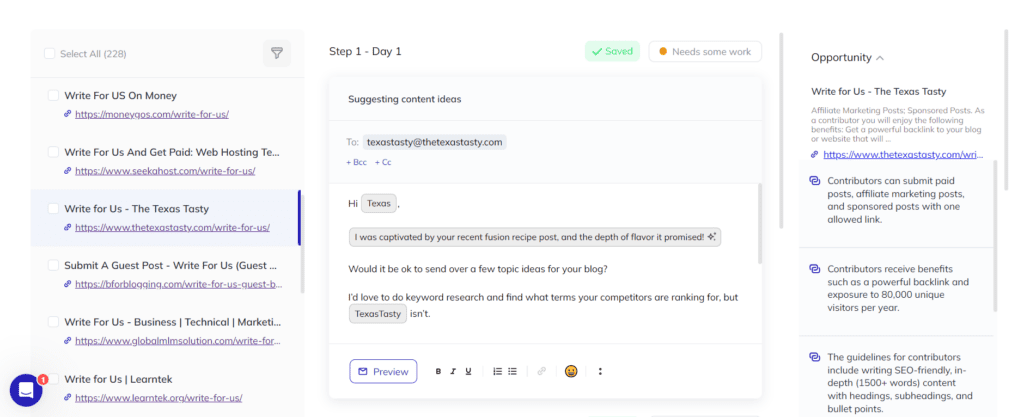
Here, all variables (including AI), will be populated.
However, you’re more than welcome to make additional, manual personalizations to increase your chances of getting a reply even futher.
When all emails are personalized and your campaign is launched, all that’s left for you to do is look out for replies.
Now, let’s move on to the next strategy.
Note that the procecss of launching a campaign is mostly the same for all strategies using Respona, so we’ll focus only on the campaign template page and search engine as these are the most notable differences.
Tactic #2: Link Insertion
The second white hat link-building tactic we’re examining here has to do with content promotion.
Like we did before, we’re using a scenario that will help us get through the process in the most clear and understandable way possible.
Say that we’ve published a blog post on SaaS marketing – which we actually did! – and we want to promote it.
In this case, we’re interested in finding websites that are relevant to our topic or might be publishing and linking back to relevant content pieces.
They should also mention our target keyword somewhere in the content but not the title – so they are not competing.
After we find them, we basically want to pitch them our resources and the valuable content that we publish on our own blog.
Our target is, as you can imagine, to get some high authority links from relevant sites and raise brand awareness of our high quality content without being spammy.
Let’s get the process of promoting our piece of content, by using Respona, started.
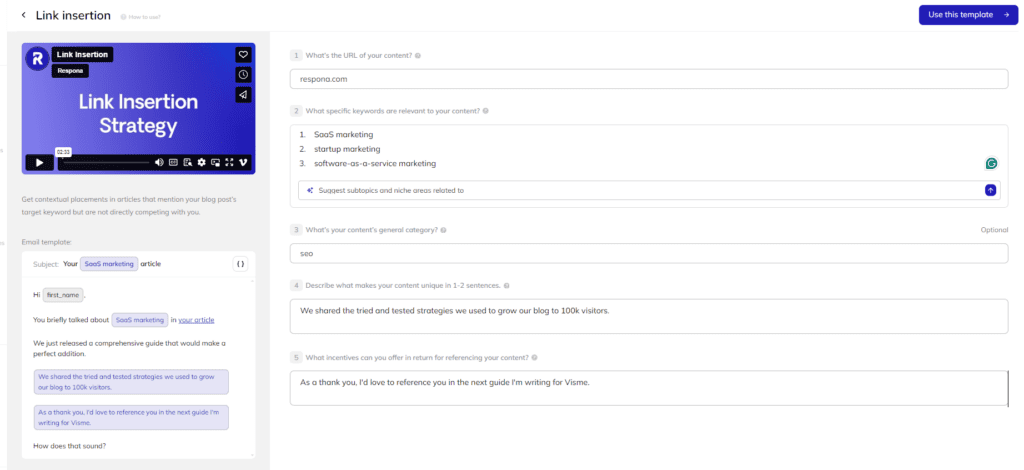
Compared to the guest posting template, there are a few more fields to fill out.
The first one is the URL of your article that you’d like to build links to. It, along with the 3d, 4th, and 5th fields will be pulled into your email sequence.
In the second one, enter a few keywords that are relevant to your content.
You can also use our AI keyword suggestions to generate 20 additional subtopics and niche areas related to your keywords and greatly broaden the search.
In the third field, enter your content’s general category.
In the last two fields, briefly describe your content and provide an incentive for your prospects to collaborate.
The full template goes as follows:
Hi, {first_name}
You briefly talked about {keyword} in your article.
We just released a comprehensive guide that would make a perfect addition.
{brief content description}
{incentive}
How does that sound?
The search algorithm for finding link insertion opportunities with Respona is similar to that with guest posting – it used Google.
However, it uses more advanced search operators, including inurl:blog, intext:, and -intitle: to narrow down the search results to only non-competing articles that mention your target keywords somewhere in the content.
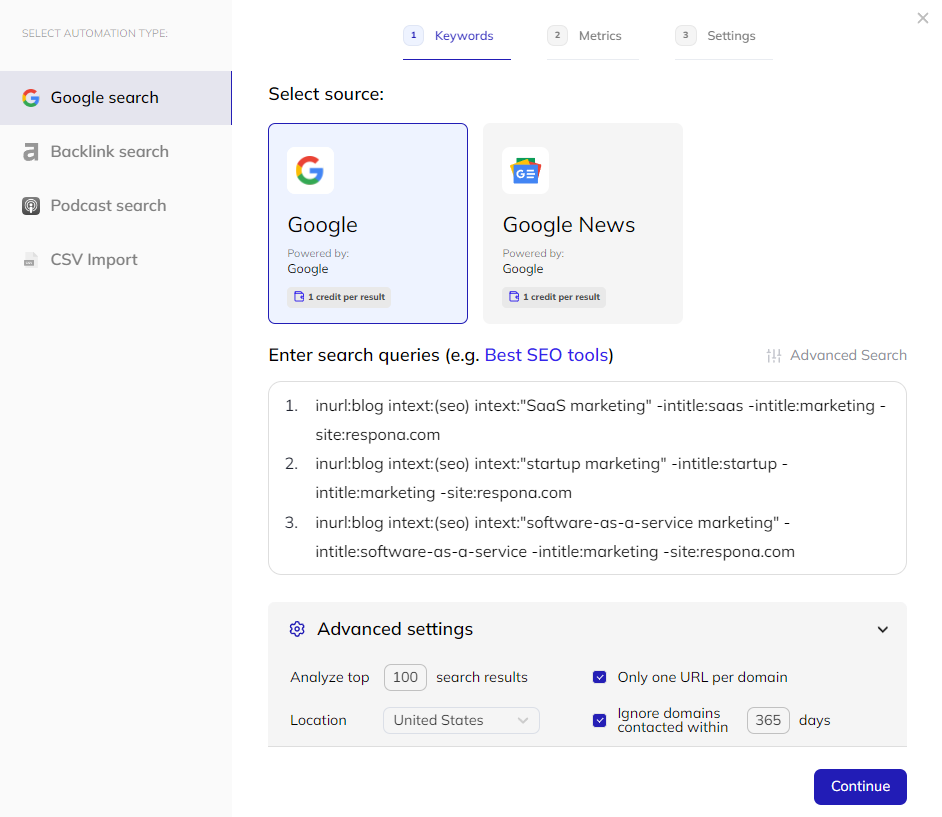
As we mentioned, the process for building your email sequence, finding contacts and personalizing pitches is almost exactly the same for all campaign types, so we won’t describe it again here.
Moving on to the next strategy.
Tactic #3: Podcast Outreach
For our final white hat link building we’re diving deep into podcast outreach.
Exactly as we did before, we’re using Respona to find podcast opportunities.
For the sake of our scenario, we’re looking to be guests on marketing-related podcasts.
We’re therefore interested in finding podcasts that are relevant to our topic so we can pitch them.
Why do that?
Because when you’re a guest on a podcast, the host will not only interview you but will most likely tag you in their social media, and importantly link back to your website when posting the podcast.
Let’s start building our campaign.
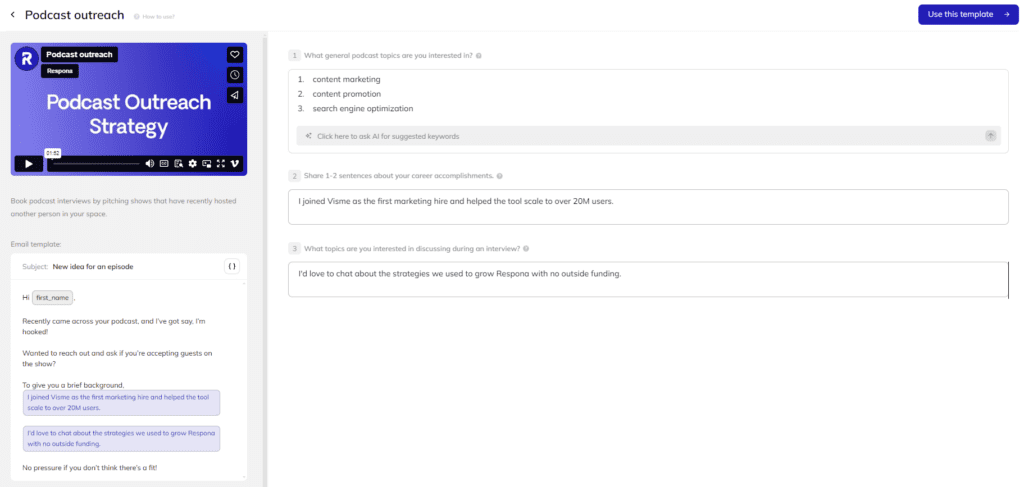
For this example, we’ll be using the general podcast outreach campaign template that looks for shows that cover specific topics.
In the first field, enter some general podcast topics you’re interested in – and feel free to use AI keyword suggestions to come up with more and expand the search.
In the second field, provide a brief backstory of your accomplishments to introduce yourself to the podcast hosts.
In the last field, propose the exact discussion topic you’d like to talk about during your appearance.
Here’s the full template:
Hi there,
Recently came across your podcast, and I’ve got say, I’m hooked!
Wanted to reach out and ask if you’re accepting guests on the show?
{background}
{proposed topics to discuss}
No pressure if you don’t think there’s a fit!
Respona is integrated with ListenNotes to find podcast opportunities.
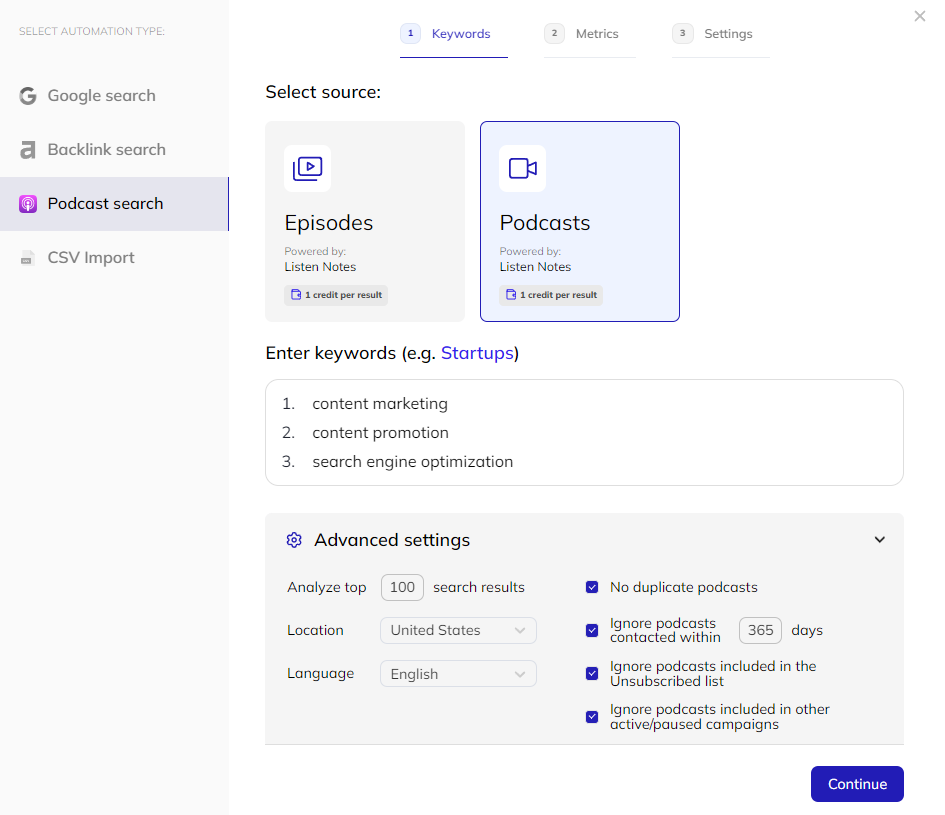
If you use any AI variables (like the Icebreaker we discussed earlier), it will “listen” to your prospects’ podcast and come up with personalizations based on what they talked about in the show.
Let’s wrap up with some final thoughts.
Link building cheat sheet
Wrapping Up
By now, you should have realized that there are various ways to do white hat link building for your website.
Not only that, but those ways are interesting and even fun, too.
They can help you establish relationships with likeminded people and expand your network within your niche or vertical.
If you’re ready to start using any of the tactics discussed above, then you should give Respona a try.
Our modern link building software works like a charm for link builders and any link building agency that wants to enhance their link acquisition efforts though white hat link building tactics.
Start your 14-day free trial and see how Respona can help you acquire white hat backlinks.






